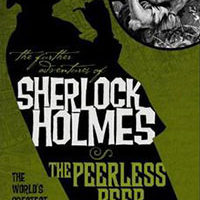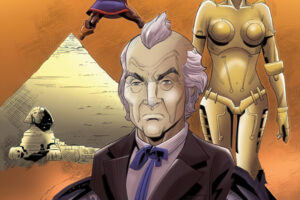 Some pulp hero fans make the mistake of lumping all the pulp heroes together into one group, as if they comprise a genre all their own.
Some pulp hero fans make the mistake of lumping all the pulp heroes together into one group, as if they comprise a genre all their own.
Sometimes it leads to some silly comparisons, such as recently when someone compared the new comic book pulp hero Lobster Johnson to Doc Savage, because they are nothing alike. Too many pulp hero fans don’t seem to grasp that pulp fiction covers a wide range of genres, and that pulp heroes do as well.
So what are these genres? They are numerous, but some of the major ones include mystery/detective/crime, adventure, science fiction, occult/horror/fantasy, weird menace, air/war, spy, western and romance. There were, of course, many other smaller genres like railroad, nursing, spicy/saucy, and so on. By far the largest was the mystery/detective genre. Some genres continue today, where as other have dwindled or disappeared.
And as noted, each pulp hero sits in one genre, though a few straddle a couple. So how might we organize some pulp heroes?
Mystery/Detective
As the largest grouping, we have the largest number of pulp heroes in this genre. Obviously the most well-know in this area include The Shadow and The Phantom Detective. To a degree The Spider falls into this group (but more on him later), along with The Avenger, The Whisperer, and Nick Carter. The many masked detectives from Thrilling and others all fall into this group, such as the Masked Detective, Green Ghost, Crimson Avenger, The Black Bat, The Purple Scar and so on. There are many minor pulp characters that fall into this group, like The Green Lama, Black Hood, the Man in the Red Hood, and many of Johnston McCulley‘s characters.
Not to be overlooked would be the many serialized detective characters and groups such as The Park Avenue Hunt Club, Carrie Cashin, Click Rush, Norgil the Magician, the Candid Camera Kid, and a host of others.
I also think that many of the pulp villains, such as Wu Fang, Dr. Yen Sin, and many of the rest fall into this area (though there are a few exceptions).
Adventure
The adventure genre had characters who travel the world to exotic locations, finding mysterious places and people. By and large, the pulp heroes that fall into the adventure genre are almost always larger-than-life and seldom disguised. The main one in this area is, of course, Doc Savage, and all his many imitators such as Jim Anthony, The Skipper, Thunder Jim Wade, Captain Hazzard, and so forth. To a degree The Avenger also falls into this area, as he was created as a sort of combo of both The Shadow (mystery/detective) and Doc Savage (adventure).
I think the various jungle heroes like Tarzan, Ki-Gor, Ka-Zar and others also fall into this area.
Science Fiction
Science fiction, in many ways, came to full flower in the pulp magazines. Sadly, this area is under-represented among the pulp heroes, though many of them do use science-fictiony stuff. The main pulp hero here is the Doc Savage-like Captain Future. I’m hard pressed to think of others, though many of Edgar Rice Burroughs’ characters like John Carter and Carson Napier fall into the science fiction genre, along with most of the “sword and planet” characters.
Occult/Horror/Fantasy
These could be seen as separate genres, but am treating them all together. By “occult/horror” I mean works by H.P. Lovecraft and associates: supernatural horror vs. serial killers and the like. Some of this overlaps with fantasy, so I am tossing them all together. As to pulp heroes, these would be mainly your occult detectives if they are addressing real (or perceived to be real) supernatural happenings. This would include characters like Ravenwood, Dr. Jules de Grandin, John Thunstone, Silver John, and others. I would also toss in pulp villains like Doctor Satan and Doctor Death as well because of the occult overtones.
Also, I think the various “sword and sorcery” characters like Conan and the like also fall into this group.
Weird Menace
I actually break out the weird menace genre separate from the occult/horror genre. That’s me. Here the horror is purely created by people, nothing supernatural. So there isn’t much in the way of pulp heroes, except that I feel that many of the Popular heroes have been influenced by this. The biggest would be The Spider, who is less a Shadow clone because of the over-the-top evil he must confront. I would also toss in the short-lived villain pulps The Octopus/The Scorpion as well in this area.
Air/War
This may be actually be viewed as a couple of genres. There are the air genre, which focuses on air adventures; and the air war/war genre, which is on future air war, and past and present war, what we might call military fiction. There are actually several pulp heroes that fall into this area. Most well known is G-8. But there are also Bill Barnes, The Griffon, Phil Strange, Richard Knight, Dusty Ayres, Captain Combat, Terrance X. O’Leary, and many others.
Spy
Obviously dealing with spies, this genre has a few pulp heroes in it. The most well known is Operator #5. Secret Agent X may fall in here (or is it detective/mystery?), along with The Eagle and the Red Finger.
Western
Long a popular genre among many, the Westerns did span several continuing characters. Zorro would fall into this area, as would the Lone Ranger. There is also Pete Rice, The Masked Rider, and a host of others I’m overlooking, as I’m not into westerns.
Romance
Okay. A romance pulp hero? Well, I’m not aware of any, though the Domino Lady seems to straddle the detective and saucy areas. And Jim Anthony was being published by the main spicy publisher.
As you look at the genres and what publishers published, it’s interesting to see the match-ups. Street & Smith tried to cover the main genres with their host of pulp heroes:
- The Shadow (detective/mystery)
- Doc Savage (adventure)
- Nick Carter (hard boiled detective)
- Pete Rice (western)
- The Skipper (sea adventure)
- The Whisperer (detective/mystery)
- Bill Barnes (air adventure)
- The Avenger (mystery & adventure)
Plus their different detective characters in Crime Busters pulp.
Popular tried several different types of heroes, though as I said, many had a weird menace element to a lesser or greater extent.
Thrilling mainly did masked detectives of various sorts, though they did do a few others.
Today’s New Pulp heroes seem to follow the major genres of detective/mystery, science fiction, and adventure. Rarer are the western, fantasy or occult type characters.
What do others think of this breakdown? Does it work, not work, any suggestions? Please realize I made no attempt at listing all the classic pulp heroes and what genre they fell into.




New Pulp has got some pretty solid representatives of other pulp genres. You’ve got the FIGHT CARD series which covers boxing. Pulpwork Press has put out three volumes of weird western tales: HOW THE WEST WAS WEIRD and Joshua Reynolds has contributed to the occult detective/mystery genre with his stories about Charles St. Cyprian, His Majesty’s Royal Occultist.
Thanks for the comments. I wasn’t trying to cover all the New Pulp genres, and keep in mind I was focusing on pulp heroes, not on all the pulp genres.
More appropriate would be speaking of the various New Pulp heroes such as The Rook, Black Centipede, Dillion, Brother Bones, etc, and where they fit in in terms of pulp genres.
Doesn’t the Shadow have some elements of Weird Menace in his stories (granted, no where near as much as The Spider)? The over the top nature of many of the villains he fought, like Shiwan Kahn and the Voodoo Master seem very much in keeping with the Weird Menace tone, contrasting other Masked Detective type characters who only fought ordinary criminals.
I wouldn’t call any of the Shadow’s villains “weird menace”. Weird Menace is much more then being over the top, but being psychotic/psychopathic. Less Joker, then, say, Jason or Freddie Kruger.
The term for characters like Shiwan Khan and Voodoo Master are ‘supercrooks’, what most people would call comic book supervillains, but not weird menace.
Interesting that you bring up LOBSTER JOHNSON. I find that one to have the most authentic pulp feel (with the possible exception of Francesco Francavilla’s BLACK BEETLE, which also incorporates elements from old time radio, movie serials, golden age comic books, and newspaper adventure strips) of the many various pulp heroes published as comic books recently, despite it not being an authentic pulp character adaptation.
In one sense, The Lobster (he is never called “Lobster Johnson” in the stories) is a generic template of the typical pulp vigilante: he guns down criminals without compunction, brands their foreheads with a lobster claw symbol or leaves a calling card with same, is wanted by the police, has a small crew of confederates, etc. Yet we actually know next to nothing about the character: who he really is, or why he became “The Lobster” (surely a strange avatar for someone seeking to strike fear into the hearts of evildoers). But we do know that his ‘real’ adventures inspired the creation of a short-lived “The Lobster Magazine” pulp in 1940 (after the real vigilante disappeared in 1939), and later a comic book series and 2 movies serials from Republic Pictures. In the pulp magazine, he was given the fictional alter ego of crippled millionaire William Johnson. In the mid-1950s, a series of Mexican horror-crime movies used the character and named him “Lobster Johnson” (picking up the surname from the pulps). This framing of the fictional legend against the ‘true’ comic stories is what makes The Lobster an interesting character. Of course all of that wouldn’t matter if the execution of the comic stories wasn’t top-notch, but you get the sense that Mike Mignola is taking special care in overseeing his characters, and only hiring top talent to write and draw them.
Lobster Johnson will be the subject of a future posting, once I do a posting on Hellboy. Am quite familiar with both characters as I have been reading the comic and several of the novels. There is even a Lobster Johnson novel.
I do have “The Satan Factory” by Tom Sneigowski (the LJ paperback novel) but haven’t got around to reading it yet. Heard nothing but positive reviews, though. Biggest critique seems to be that the Lobster isn’t really even the main character in the book, but I suppose they can’t get ahead of the comic stories in revealing the character’s background. When I first bought it, I was under the impression that it was supposed to function as part of the “fictional Lobster” – a “1960s paperback reprint” of the already-mentioned pulp stories, but I found out that isn’t the case.